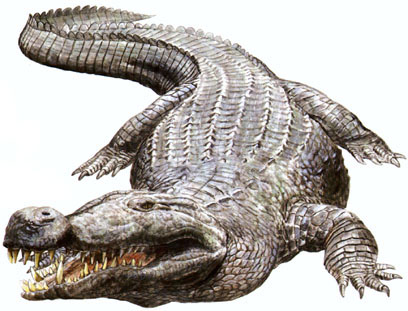| Alligators

History of the Alligator
The American alligator (Alligator Mississipiensis),
which is commonly referred to as the American
"Gator", currently thrives in the vast
wetlands of Florida. However, this was not always
the case. Facing possible extinction, these cold-blooded
reptiles were added to the national endangered
species list in 1967. The severe decline of gators
in Florida and other regions of the U.S. was due
primarily to excessive market hunting and habitat
loss. Despite their near extinction in the 60's,
the Florida gator was able to make a full recovery
and was taken of the endangered species list in
1987. The gator’s amazing come-back was
made possible only through a great collaborative
effort at both the state and federal levels. The
passing of various gator protection laws, and
the establishment of important programs that monitor
gator populations were key elements in the survival
of the Florida gator. Even today these state and
federal guidelines work together to protect and
secure the gator population for further generations.
On occasion, people misspell alligator as 'aligator'
which is why its easier to just call them 'gators'.
Habitats of gators
The Florida gator currently resides in various
wetlands, swamps, rivers, creeks, ponds, canals,
and any other fresh body of water that it can
find in Florida. It has even been discovered that
some Florida gators have declared residency in
brackish water, claiming various estuaries and
marshes as home. The most famous of all Florida
gator habitats is the Florida Everglades. This
one of a kind ecosystem supports numerous unique
species of animals and vegetation. Unfortunately,
the Everglades faces possible annihilation, which
will mean the loss of numerous important animal
and plant life, including the Florida gator.
Eating Habits of the gator
Gators are carnivores and primarily feed at night.
They will eat almost anything that is smaller
than they are. Their diet includes, fish, birds,
small mammals, snakes, turtles and even other
gators. Florida homes that reside along lakes
and other bodies of water must be aware of any
neighboring gators, especially if the home owner
has pets. Gators generally avoid humans, however
they have been known to occasionally prey on pets.
In response to this and other gator related problems,
Florida established a nuisance control program
in 1978.
Physical Appearance of Alligators
Adult gators are black, have large rounded snouts
and razor sharp teeth. Gators are generally between
6-14 feet in length and live between 50-60 years.
The largest recorded gator in history measured
twenty feet in length. One of the most important
and strongest features of the Florida gator is
its powerful tail, which accounts for half of
its length. This vital appendage can be used as
both a deadly weapon and a method of self-propulsion
in the water. With this in mind, a Florida gator
can stealthily cut through water with razor-like
precision by just making a few graceful movements
with its agile tail.
Some Interesting Information about gators
Along with various other talents, gators are
capable of floating slightly above the surface
of water. When gators do this type of "dead
man’s float" in the water, their camouflaged
bodies complimented by their water buoyancy give
these sneaky creatures the appearance of a harmless
log adrift in the water. By mimicking a piece
of dead wood, gators allow nearby animal bystanders
to feel at ease with a false sense security while
the Florida Gator is provided with an opportunity
to catch dinner. One talent that Gator lack is
the ability to run fast on land. Gators were built
for speed in the water, however they were poorly
designed for running long distances on land. It
is true that Florida gators can obtain moderately
fast speeds on land for short distances, however,
they lack the endurance necessary to sustain those
speeds for any considerable amount of time.
Reproduction in gators
Breeding season for the Florida gator begins
in the Spring. During this time of year, female
gators keep themselves busy with building nests
for their future young. Gator nests are primarily
composed of decaying vegetation, sticks, mud,
and leaves. Gators will construct their nests
in areas that are both convenient to water and
well sheltered. These nests can be several feet
high and span across 6 feet of shoreline. A female
gator produces between 20- 50 white eggs that
are similar in size to a goose egg. Once laid,
gator eggs are covered up with decaying vegetation.
This rotting plant life serves as a heat blanket,
which incubates the gator eggs for somewhere around
65 days. The temperature at which the eggs are
heated determines the sex of each gator hatchling.
A baby gator is about 9 inches long at hatching
and weighs in at a mere 2 ounces. On average young
gators will grow rapidly (one foot each year)
until they reach age six.
Gators have been around for millions of years,
and it is likely, they will remain for millions
more.
|